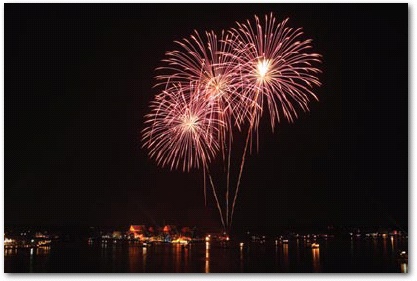Fireworks
Q: What do fireworks shots have in common with milky waterfalls?
A: They both rely on slow shutter speeds; you're actually recording your subject's motion over time.
In the case of fireworks, you get the colorful, brilliant trails of fire against the black sky.
Arrive early to get a good spot. Beware setting up downwind of the smoke, which will interfere with both your shooting and your breathing.
The next steps vary slightly, depending on what kind of camera you have.
SLRs and Manual-Control Compacts
Use your M (full manual) mode. You'll be using a very slow shutter speed, so a tripod or another stable platform is essential. Now:
Turn off the flash.
Dial up a long shutter speedâmaybe 4 to 8 seconds, to start. The longer the exposure, the more fireworks trails you'll capture.
Adjust the aperture. Set it to something small, like f5.6 or f8. That small aperture will prevent "blooming" (bleeding) of light in the fireworks, which should help keep the images crisp.
Set a low ISO (100 or 200, for example) to avoid "noise" (Goose the ISO).
Use manual focus. Turn it to "infinity" (the â symbol)âthat is, focus on the most distant spot possible, to prevent the camera from futilely hunting for focus in the dark.
Use the self-timer, remote control, or a shutter-release cable so you don't have to touch the camera.

If the picture comes out too bright, make the aperture smallerâf11, for example. ...
Get David Pogue's Digital Photography: The Missing Manual now with the O’Reilly learning platform.
O’Reilly members experience books, live events, courses curated by job role, and more from O’Reilly and nearly 200 top publishers.

